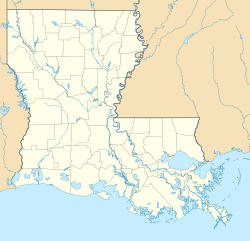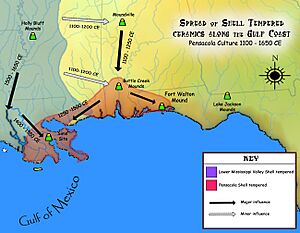Sims site facts for kids
| Location | Paradis, Louisiana, Saint Charles Parish, Louisiana, |
|---|---|
| Region | Saint Charles Parish, Louisiana |
| Coordinates | 29°51′17.46″N 90°27′11.52″W / 29.8548500°N 90.4532000°W |
| History | |
| Founded | 850 CE |
| Abandoned | 1700 |
| Cultures | Coastal Coles Creek culture, Plaquemine Mississippian culture |
| Site notes | |
| Excavation dates | 1978, 1979, 1980 |
| Responsible body: private | |
The Sims site (also known as Sims Place site) is an ancient place where people used to live. It is an archaeological site located in Saint Charles Parish, Louisiana, near the town of Paradis. This site has platform mounds and large areas with ancient trash, called middens.
People lived at the Sims site during three main time periods. The first group arrived around 800 CE. They were part of the Coastal Coles Creek culture. Around 1100 CE, the people living there changed to the Plaquemine culture. This culture was influenced by the larger Mississippian culture. This period lasted until about 1450 CE. Later, from 1500 to 1700 or 1800, there was a final period of occupation.
What Does the Sims Site Look Like?
The Sims site is very large. It is found along both sides of a small stream called Bayou Saut d'Ours. Long ago, it had five or six earthen mounds. Today, only two mounds and parts of a third can still be seen. One mound, called Mound A, has a cemetery from more recent times on top of it.
The Sims site was likely the biggest and most important place in its area. It probably served as a center for community gatherings and special ceremonies. It was also a key place for trade. The people living there traded local items like shells and shell beads. They exchanged these goods with other groups living further up the Mississippi River valley.
How Do We Know About Trade?
Archaeologists study ancient pottery to learn about trade. At the Sims site, people first used a type of clay called grog to make their pottery strong. This was typical for the Plaquemine culture. Over time, they started using shell-tempered pottery. This type of pottery was common in other areas.
By looking at these changes in pottery, experts can see how the Sims site people traded with others. During the second period of occupation (1100 to 1450 CE), trade grew a lot. Pottery found at the site shows connections to groups from the Lower Mississippi Valley. It also shows links to Plaquemine people near Barataria Bay. There were also connections to the Pensacola culture near Biloxi, Mississippi.
This time was when the Bottle Creek site was growing. Bottle Creek was a major center for the Pensacola culture. The Sims site had its strongest connections to the Plaquemine culture during this period. Later, the Sims site people had more contact with Mississippian-influenced Plaquemine groups. These groups came from as far north as the Baton Rouge area. They also continued to trade with the Mississippian Pensacola people.



